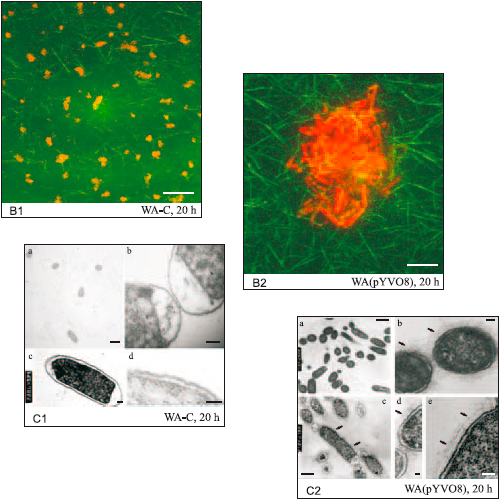Unusual, Virulence Plasmid-Dependent Growth Behavior of Yersinia enterocolitica in Three-Dimensional Collagen Gels
04-Apr-2008
Journal of Bacteriology, 2008, 190, 12, 4111-20 published on 04.04.2008
Journal of Bacteriology, online article
Journal of Bacteriology, online article
As a first approach to establishing a three-dimensional culture infection model, we studied the growth behavior of the extracellular pathogen Yersinia enterocolitica in three-dimensional collagen gels (3D-CoG). Surprisingly, we observed that plasmidless Y. enterocolitica was motile in the 3D-CoG in contrast to its growth in traditional motility agar at 37°C. Motility at 37°C was abrogated in the presence of the virulence plasmid pYV or the exclusive expression of the pYV-located Yersinia adhesion gene yadA. YadA-producing yersiniae formed densely packed (dp) microcolonies, whereas pYVyadA-carrying yersiniae formed loosely packedmicrocolonies at 37°C in 3D-CoG. Furthermore, we demonstrated that the packing density of the microcolonies was dependent on the head domain of YadA. Moreover, dp microcolony formation did not depend on the capacity of YadA to bind to collagen fibers, as demonstrated by the use of yersiniae producing collagen nonbinding YadA. By using a yopE-gfp reporter, we demonstrated Ca2-dependent expression of this pYVlocalized virulence gene by yersiniae in 3D-CoG. In conclusion, this study revealed unique plasmid-dependent growth behavior of yersiniae in a three-dimensional matrix environment that resembles the behavior of yersiniae (e.g., formation of microcolonies) in infected mouse tissue. Thus, this 3D-CoG model may be a first step to a more complex level of in vitro infection models that mimic living tissue, enabling us to study the dynamics of pathogen-host cell interactions.











